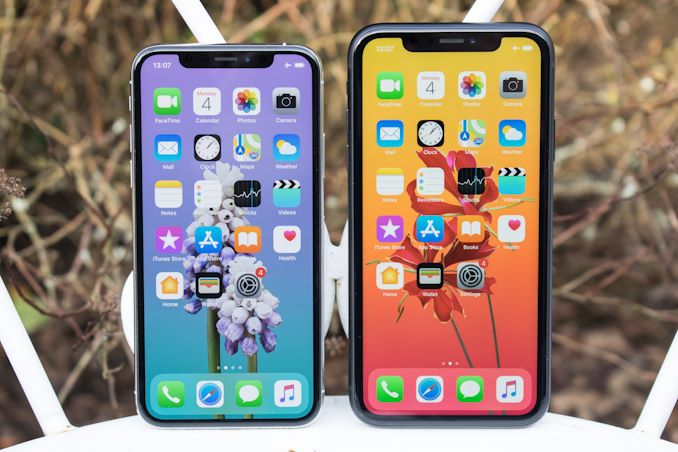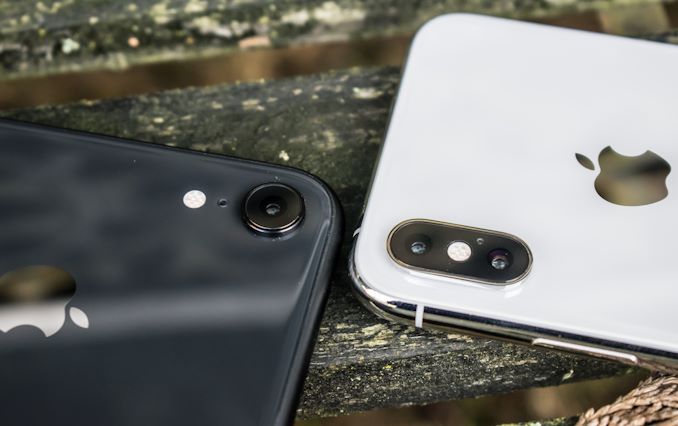The Apple iPhone XR Review: A Different Display Leads To Brilliant Battery Life
by Andrei Frumusanu on February 5, 2019 9:45 AM EST- Posted in
- Mobile
- Apple
- Smartphones
- iPhone XR
Conclusion & End Remarks
The iPhone XR is an interesting phone for Apple simply because of its price positioning. Starting at $749, it’s $250 cheaper than the base iPhone XS, and $350 cheaper than the iPhone XS Max. And this is a gap that continues straight up to the max capacity 256GB models. So the big question here for most users is if the iPhone XR’s differences represent reasonable compromises for the lower price.
From a design standpoint, the iPhone XR comes in the same industrial design as the iPhone XS variants – both of which follow up on the previous generation iPhone X. The big difference here is in the bezels, which are notably larger on the iPhone XR. It does not represent any deal-breaker for the phone and it’s something that I guess most users will get used to – but my gripe is still that with a $749 price tag, the design feels more like something that would have come from a budget smartphone. Apple’s choice of insisting on a symmetric bezel design isn’t something that I personally find appealing in this implementation – but I do know some other users prefer this kind of design over asymmetric bezels (though you could argue the notch makes it asymmetric anyhow…).
The one thing that surprised me the most when using the iPhone XR is that even though it’s a smaller phone than the XS Max, it doesn’t always actually feel all that smaller. Here the increased thickness of the phone does change the in-hand feel quite a lot, and it will feel bigger than you’d expect for a phone with its 75.7mm width.
The main (and most visible) difference between the XR and its XS is inarguably the screen. Among the reasons Apple is able to offer the XR at a cheaper price point is eschewing an OLED panel in favor of a more traditional LCD. In terms of the fundamentals of the LCD in the iPhone XR, Apple continues to employ some of the best panels in the industry, and the iPhone XR is no exception to this. Brightness, contrast ratio (for an LCD), viewing angles, and colour calibration are all top-notch and will not disappoint.
The one area where I think Apple went too conservative is with the display resolution. For the majority of users this will be a subjective matter and it will depend on how they use their phones, but I personally found it among the larger compromises made, and something that would be a deciding factor for me to opt against getting the XR. For anybody else who never use their phones closer than at arm’s length or are less sensitive to the resolution difference, it should not represent any major drawback.
With that said, Apple’s choice to go with an LCD display has a very important side-effect for the iPhone XR: because it avoids the double-edged sword that is a higher-end OLED, it also avoids the technology's higher base power consumption. This increased base power consumption was the reason why the XS Max lasted a notably shorter period of time than the iPhone 8 Plus. The iPhone XR avoids this problem, and in conjunction with the fantastic A12 SoC, the phone is able to achieve Apple’s best ever battery results in our tests. Lasting 25% longer than the iPhone XS Max, this represents a major improvement in battery life and is going to make all the difference for users who value it above everything else. For those users, the cheaper iPhone XR may very well be the better choice.
The performance of the iPhone XR is very much in line with the XS – meaning you’ll be getting an industry leading experience. An important factor for users who value gaming a lot is that, as a side-effect of the lower-resolution screen, the iPhone XR gets better GPU performance and better power efficiency as the phone is only pushing 44% of the pixels of the XS Max. This means longer gaming battery runtimes in current games, and better experiences in future, more demanding games.
The camera on the iPhone XR is pretty straightforward: It’s the same fantastic experience as on the iPhone XS, with the only difference being that it lacks the telephoto lens. Apple’s strengths here are their absolutely great capture experience, which is among the most consistent of current generation smartphones, as well as class-leading picture quality that ties with the best of the competition. Low-light performance is good, but as was the case with the XS, the Android handset vendors have seen immense jumps over the last year due to their usage of computational photography and better sensors, and it’s something that Apple just currently lags behind at.
The lack of a telephoto lens is one of the more justifiable compromises for the lower prices – it’s something that I might miss, but it’s also not a deal-breaker for the phone and I could very easily live without it.
Finally, the big question is if the iPhone XR represents a good value and if it’s a viable choice for users. I think the deciding factor for most users is whether they find the design/ergonomics of the phone acceptable, as well as the display's pixel density. If so, then the iPhone XR certainly seems to represent a better value than the XS alternatives.
Wrapping things up, I find myself coming back to my final paragraph of the iPhone XS review, where I had mentioned that Apple is asking for a lot of money for their new models. At the time I thought that this was a risky pricing strategy for the company, and it seems that Apple is feeling some of the side-effects here as smartphone revenue has dropped year-over-year.
Similarly, I think the iPhone XR is also priced a tad too high, and if you’re not entrenched in the iOS ecosystem, there are better value alternatives. I count myself among those who wouldn’t buy a smartphone at this price, and certainly not if it does compromise on some features. In a way this might be the rationale of more users, and that’s probably why the iPhone XR has seen less demand than anticipated. With hindsight, I see now what I might have been wrong in thinking the XR would be the most popular model of this generation, as it’s not priced low enough to convince users to drop down from what they see as the better long-term investment of an XS variant. That is if they would buy a new iPhone at all this generation, which with the ever increasing prices, is an ever increasingly hard choice to make.












89 Comments
View All Comments
eastcoast_pete - Wednesday, February 6, 2019 - link
Interesting point. I don't know enough about the details of Apple's OLED displays on the XS and the Max, but, if you're right, it also means that Apple's claimed pixel density is slightly dishonest, or at least in need of a footnote. Now, regardless of density, the XS and Max have a very good looking and crisp display, as they should at those prices.mkozakewich - Thursday, February 7, 2019 - link
That's a good assessment. I find I like the pentile arrangement more, but only if it's got the same base density as an rgb stripe. The crops of the XS and XR show how similar they are except for the subpixel layout.Ananke - Tuesday, February 5, 2019 - link
When I compare my iPhone8 display to my Galaxy 8 or 9 displays - the difference is huge. iPhone XR has the same 720p display. It is not bad, but definitely less sharp and less colorful then Samsungs, and definitely not worth $750. The XR would've been a perfect buy around $400, or free-$100 per line after contract, but indeed I agree with the previous comment - Apple created it just to have something that doesn't jeopardize its XS sales. Apple simply wants average sale price to be above the $1000 mark, and that's it. Simple. We all saw how it worked for them on Wall Street though :) :)uhuznaa - Tuesday, February 5, 2019 - link
Absolutely, yes. Apple could have used a higher resolution display and made the battery a bit smaller to arrive at the same or even less thickness as the XS (-0.6 mm), but then fewer people would buy the more expensive iPhones with a better margin for Apple. They're fully in the zero-sum mindset now, which is a natural consequence of trying to maximize profits instead of market share.jakoh - Tuesday, February 5, 2019 - link
Maximizing profits can sometime start to bite you.Apple phones are so expensive.
I understand that Samsung phones are expensive too. But often you can get a note 9 for $750-799. When can you say that about iPhone Xs or Xs max?
mrochester - Tuesday, February 5, 2019 - link
Probably in a couple of years time.cha0z_ - Monday, February 11, 2019 - link
I got my note 9 on contract from my carrier for half the price that I would had given for iphone xs max from the carrier too. I literally could had taken 2 note 9 phones instead of one iphone. No carrier sub for iphones and this creates insane price differences, then I would have to buy a new charger as the one in the box is insanely slow and headphone adapter. Even if we agree that the xs max is a better phone (tho this can be debated as some things that the note 9 can do, the iphone can't) - it's not that much better to spend twice the money on it, but each on it's own for that one.lightsout565 - Tuesday, February 5, 2019 - link
"I think the main issue I have with the iPhone XR’s display is that it’s actually somewhat of a downgrade from the iPhone 8 and 8 Plus in terms of resolution – while I understand that Apple wanted to use a more affordable panel, I do think it would have prudent to at least match the 401ppi pixel density of an iPhone 8 Plus."It's only a downgrade when compared to the 8 Plus. The XR and the 8 have the same PPI so this wording is a little misleading.
Also, when comparing the 100% crop of the XS and XR, the main noticeable difference as you say was the clock icon numbers. This text is at a point size that no-one would realistically be reading in practice. I'd be more interested in 100% crops of the the icon label text, the text in a message/email, etc. I'm curious how the sharpness holds up on larger system fonts at a point size you'd realistically be reading.
tipoo - Tuesday, February 5, 2019 - link
I have a 7 at the same 326PPI and I easily see some graininess around text at any size fwiw. Same with the curves on icons and notification dots.jell0king - Tuesday, February 5, 2019 - link
After owning an XR and returning it to get a year old X I have to agree with your assessment of the design of the phone: It's just to thick.The thickness of the phone is immediately noticeable and i hadn't even put a case on it yet. The X/XS/XS Max are infinitely more comfortable to hold for extended periods of time. Why I haven't seen this mentioned in other reviews is mind boggling but for me the phone was very uncomfortable to hold.
I could live with the low res screen and thick bezels, loved the battery life and I enjoy the 'fun' colors...but that thickness was just a deal-breaker.